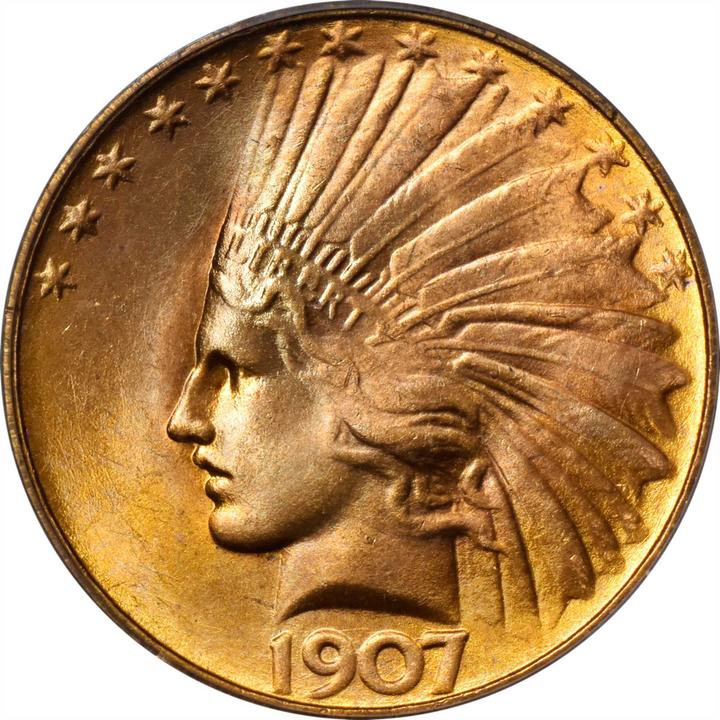
A rare $10 gold coin designed by sculptor Augustus Saint-Gaudens in 1907 was auctioned off for $1.14 million at Stack’s Bowers Galleries in Costa Mesa, California, this week. Only 40 “Rounded Rim” Indian Eagle coins survive, making this a major occasion for numismatists.
It was the top lot in the auction house’s “Dr. Paul and Rosalie Zito Collection” sale on April 5. For a relatively short period, between September 1995 and August 2003, the Zitos collected prolifically, purchasing some of the most sought-after specimens ever produced by the Unites States Mint. Paul died in 2005, and Rosalie in 2011, and their family has held on to their 92-coin collection ever since. Overall, the auction raked in $4.3 million.
The $10 coin that led the sale, described by the house as “among the very finest known” examples, has a notable history. President Theodore Roosevelt personally enlisted Saint-Gaudens to redesign the nation’s gold coinage, including the $10 coin, which since 1838 had featured a neoclassical rendition of Lady Liberty in a coronet by Christian Gobrecht, chief engraver of the United States Mint.
It was Roosevelt who insisted that Saint-Gaudens depict Liberty wearing not a laurel crown, but a war bonnet, the feathered headdress traditionally worn by male leaders among the American Plains Indians. The reverse shows a bald eagle with arrows and an olive branch, based on the “defiant eagle” the artist designed for Roosevelt’s 1905 inaugural medal.
Augustus Saint-Gaudens, 1907 Indian Eagle coin, Wire Rim (recto). This is the artist’s original design, which was too high-relief and therefore could not be stacked. It sold for $840,000 at Stack’s Bowers Galleries. Photo courtesy of Stack’s Bowers Galleries, Costa Mesa, California.
The Rounded Rim Indian Eagle coin was produced by accident—Saint-Gaudens’s original design had too concave a surface, which meant the coins didn’t stack properly. The nation’s chief engraver, Charles Barber (who preferred coin design be restricted to mint employees), came up with an alternate version that solved the problem. But Saint-Gaudens also completed a revised design that Barber approved to enter circulation.
Due to a misunderstanding, however, Barber’s Rounded Rim version was mistakenly put into production instead of Saint-Gaudens’s finalized design. When the error was realized, the 31,500 or so coins already minted were melted down.
Only 50 were saved, and “given to museums of art and officials and others connected with the work,” according to mint director Frank Leach in his 1917 memoir, Recollections of a Newspaperman. The Zitos purchased their Rounded Rim coin in March 2003.
Augustus Saint-Gaudens, 1907 Indian Eagle coin, Wire Rim (verso). This is the artist’s original design, which was too high-relief and therefore could not be stacked. It sold for $840,000 at Stack’s Bowers Galleries. Photo courtesy of Stack’s Bowers Galleries, Costa Mesa, California.
The sale also included Saint-Gaudens’s earlier “Wire Rim” version of the coin, which was the second highest-priced lot of the sale, at $840,000. Acquired by the couple in 1998, it is one of 542 copies of the original high-relief design by the artist, which was deemed impractical for circulating currency. But even after Roosevelt agreed to the altered design, he was committed to bringing the artist’s original vision to life.
“As for the high-relief coins, have several hundred struck and allow the collectors of the country to obtain specimens,” the president wrote in a letter to the mint. “They should be preserved as the work of a great American artist.”
Ultimately, 472 Wire Rim coins sold, with the rest melted down by the mint in 1915. Saint-Gaudens, unfortunately, did not live to see a single coin struck, dying of cancer on August 3, 1907.
1795 Draped Bust Silver Dollar coin. It sold for $780,000 at Stack’s Bowers Galleries. Photo courtesy of Stack’s Bowers Galleries, Costa Mesa, California.
The auction also included the sale of a 1795 Draped Bust silver dollar for $780,000—far short of the $1.25 million estimate, based on the coin’s current PCGS Price Guide value.
The coin, which had been in the Zitos’ collection since May 1996, features a portrait of Liberty with a rim of stars on the front and an eagle on a cloud surrounded by an open wreath on the back. Minted from 1795 to 1803, the coin carries an auction record of $1.05 million, set for a very early version at Stack’s Bowers in May 2016.